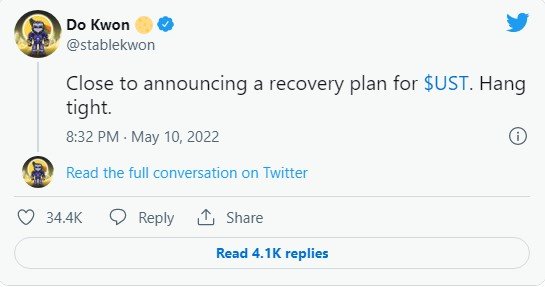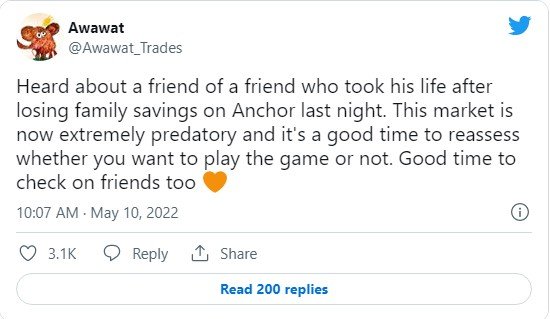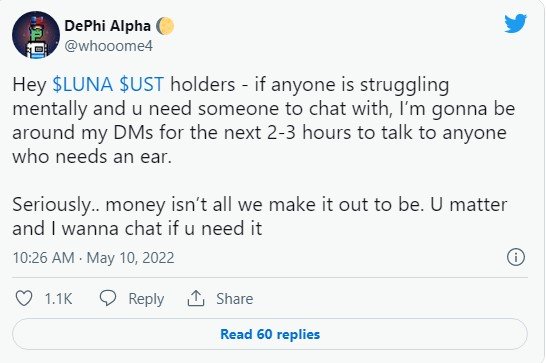Cryptocurrency Luna Lurches as Terra USD Volatility Continues, Erasing Billions
Do Kwon claims he is "close to announcing a $UST recovery plan."
LFG has deployed its BTC reserves, but a $1 billion reduction in circulating supply has so far failed to restore the dollar peg, with UST trading around 90 cents.
Critics have long expressed concerns about the viability of an uncollateralized stablecoin.
Retail customers who have relied on Terra's Anchor Protocol as a secure, high-yielding savings account are facing an unpleasant new reality.
Since Saturday, Terra USD (UST) has been trading well below its dollar peg, but the initial drop to 98 cents proved to be a foreshadowing of a much larger drop. It has even piqued the interest of US Treasury Secretary Janet Yellen, who specifically mentioned UST in Congressional testimony today.
While Do Kwon's Terraform Labs and the Luna Foundation Guard struggle to restore regularly scheduled programming, everyone is wondering if the project can be saved. And how so?
According to CoinGecko, the previously stable coin fell to just under 70 cents at one point in the last 24 hours. This extended de-peg has resulted in massive withdrawals from the prominent Terra blockchain dApp Anchor, which has seen its deposits fall by approximately $7.8 billion.
Already, the net UST supply decline totals almost $1 billion. As each UST is redeemed for one LUNA, the latter's supply grows. Since the uproar began on May 7, the protocol has generated around 25 million LUNA.
The additional supply has crushed the price of Terra's native asset, which has dropped by 64% in the last week, according to Blockworks data.
On Tuesday, Terra mastermind Do Kwon sought to assuage fears once more through Twitter, speculating on an imminent – though vague – recovery strategy.

Monday craziness
After falling to 92 cents at 2:30 p.m. ET on Monday, UST appeared to stabilise for a few hours, but things quickly deteriorated beginning at 6:15 p.m., as UST began a two-hour decline to a low of around 65 cents.
Unlike the previous weekend's price activity, which focused on UST trading via centralised exchanges and the Ethereum dex Curve, the high volatility this time drove UST off the Terra chain directly. The speed of the slide surpassed the protocol's intended arbitrage-based stability mechanism, which has a $290 million per day soft cap for redemptions at $1.
If the cap is exceeded, the spread — the amount of LUNA that one UST can be redeemed for — is intended to widen. The approach is intended to prevent manipulation of the system, but it also makes recovery from such a strong shock a difficult slog.
Algorithmic stablecoins are still in their early stages and have previously failed horribly. The Waves-based stablecoin USDN, for example, fell to 77 cents in early April and has never fully recovered. It utilized a burn and mint stabilizing technique similar to UST's, and the platform's WAVES token has dropped by 80 percent since.
UUST itself suffered a similar volatility-induced crash in May 2021, when it briefly hit 96 cents. But on a 1-year chart, that now appears as a minor bump in the road.

Many members of the Luna community, who call themselves “lunatics,” have expressed support for the protocol and its backers, even in difficult times. But for some, irrespective of whether the peg ultimately recovers, it has been a catastrophic loss.


The instability comes as no shock to crypto veterans, according to Mark Richardson, head of research at Bancor, a decentralized exchange and liquidity protocol.
“If you ask anyone from around the industry whether or not this is a surprise at all, everyone will tell you that they’re surprised this didn’t happen sooner,” Richardson told Blockworks.
Your post was upvoted and resteemed on @crypto.defrag